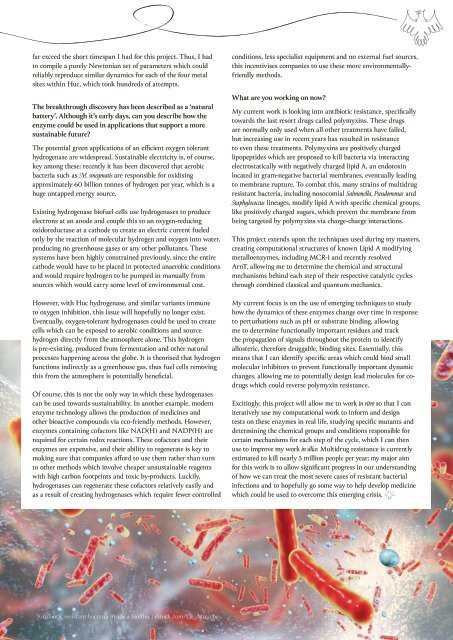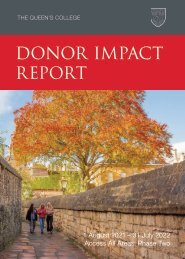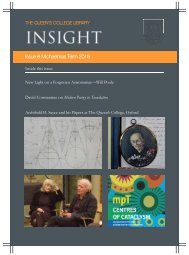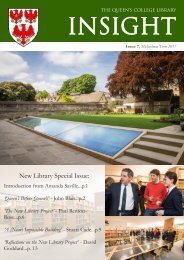Eagle Eye Magazine Issue 1 2023
Take a dive into the research and work that's going on at The Queen's College and beyond its walls within the community of Old Members. In issue one, we celebrate Shakespeare's First Folio, ask our history Fellows what makes them passionate about their subject, explore the new accessible Porters' Lodge, ask a current student about how to engage positively with climate issues, and much more.
Take a dive into the research and work that's going on at The Queen's College and beyond its walls within the community of Old Members. In issue one, we celebrate Shakespeare's First Folio, ask our history Fellows what makes them passionate about their subject, explore the new accessible Porters' Lodge, ask a current student about how to engage positively with climate issues, and much more.
You also want an ePaper? Increase the reach of your titles
YUMPU automatically turns print PDFs into web optimized ePapers that Google loves.
far exceed the short timespan I had for this project. Thus, I had<br />
to compile a purely Newtonian set of parameters which could<br />
reliably reproduce similar dynamics for each of the four metal<br />
sites within Huc, which took hundreds of attempts.<br />
The breakthrough discovery has been described as a ‘natural<br />
battery’. Although it’s early days, can you describe how the<br />
enzyme could be used in applications that support a more<br />
sustainable future?<br />
The potential green applications of an efficient oxygen tolerant<br />
hydrogenase are widespread. Sustainable electricity is, of course,<br />
key among these: recently it has been discovered that aerobic<br />
bacteria such as M. smegmatis are responsible for oxidising<br />
approximately 60 billion tonnes of hydrogen per year, which is a<br />
huge untapped energy source.<br />
Existing hydrogenase biofuel cells use hydrogenases to produce<br />
electrons at an anode and couple this to an oxygen-reducing<br />
oxidoreductase at a cathode to create an electric current fueled<br />
only by the reaction of molecular hydrogen and oxygen into water,<br />
producing no greenhouse gases or any other pollutants. These<br />
systems have been highly constrained previously, since the entire<br />
cathode would have to be placed in protected anaerobic conditions<br />
and would require hydrogen to be pumped in manually from<br />
sources which would carry some level of environmental cost.<br />
However, with Huc hydrogenase, and similar variants immune<br />
to oxygen inhibition, this issue will hopefully no longer exist.<br />
Eventually, oxygen-tolerant hydrogenases could be used to create<br />
cells which can be exposed to aerobic conditions and source<br />
hydrogen directly from the atmosphere alone. This hydrogen<br />
is pre-existing, produced from fermentation and other natural<br />
processes happening across the globe. It is theorised that hydrogen<br />
functions indirectly as a greenhouse gas, thus fuel cells removing<br />
this from the atmosphere is potentially beneficial.<br />
Of course, this is not the only way in which these hydrogenases<br />
can be used towards sustainability. In another example, modern<br />
enzyme technology allows the production of medicines and<br />
other bioactive compounds via eco-friendly methods. However,<br />
enzymes containing cofactors like NAD(H) and NADP(H) are<br />
required for certain redox reactions. These cofactors and their<br />
enzymes are expensive, and their ability to regenerate is key to<br />
making sure that companies afford to use them rather than turn<br />
to other methods which involve cheaper unsustainable reagents<br />
with high carbon footprints and toxic by-products. Luckily,<br />
hydrogenases can regenerate these cofactors relatively easily and<br />
as a result of creating hydrogenases which require fewer controlled<br />
conditions, less specialist equipment and no external fuel sources,<br />
this incentivises companies to use these more environmentallyfriendly<br />
methods.<br />
What are you working on now?<br />
My current work is looking into antibiotic resistance, specifically<br />
towards the last resort drugs called polymyxins. These drugs<br />
are normally only used when all other treatments have failed,<br />
but increasing use in recent years has resulted in resistance<br />
to even these treatments. Polymyxins are positively charged<br />
lipopeptides which are proposed to kill bacteria via interacting<br />
electrostatically with negatively charged lipid A, an endotoxin<br />
located in gram-negative bacterial membranes, eventually leading<br />
to membrane rupture. To combat this, many strains of multidrug<br />
resistant bacteria, including nosocomial Salmonella, Pseudomonas and<br />
Staphylococcus lineages, modify lipid A with specific chemical groups,<br />
like positively charged sugars, which prevent the membrane from<br />
being targeted by polymyxins via charge-charge interactions.<br />
This project extends upon the techniques used during my masters,<br />
creating computational structures of known Lipid A modifying<br />
metalloenzymes, including MCR-1 and recently resolved<br />
ArnT, allowing me to determine the chemical and structural<br />
mechanisms behind each step of their respective catalytic cycles<br />
through combined classical and quantum mechanics.<br />
My current focus is on the use of emerging techniques to study<br />
how the dynamics of these enzymes change over time in response<br />
to perturbations such as pH or substrate binding, allowing<br />
me to determine functionally important residues and track<br />
the propagation of signals throughout the protein to identify<br />
allosteric, therefore druggable, binding sites. Essentially, this<br />
means that I can identify specific areas which could bind small<br />
molecular inhibitors to prevent functionally important dynamic<br />
changes, allowing me to potentially design lead molecules for codrugs<br />
which could reverse polymyxin resistance.<br />
Excitingly, this project will allow me to work in vitro so that I can<br />
iteratively use my computational work to inform and design<br />
tests on these enzymes in real life, studying specific mutants and<br />
determining the chemical groups and conditions responsible for<br />
certain mechanisms for each step of the cycle, which I can then<br />
use to improve my work in silico. Multidrug resistance is currently<br />
estimated to kill nearly 5 million people per year; my major aim<br />
for this work is to allow significant progress in our understanding<br />
of how we can treat the most severe cases of resistant bacterial<br />
infections and to hopefully go some way to help develop medicine<br />
which could be used to overcome this emerging crisis.<br />
Antibiotic resistant bacteria inside a biofilm | iStock.com/Dr_Microbe<br />
25

















